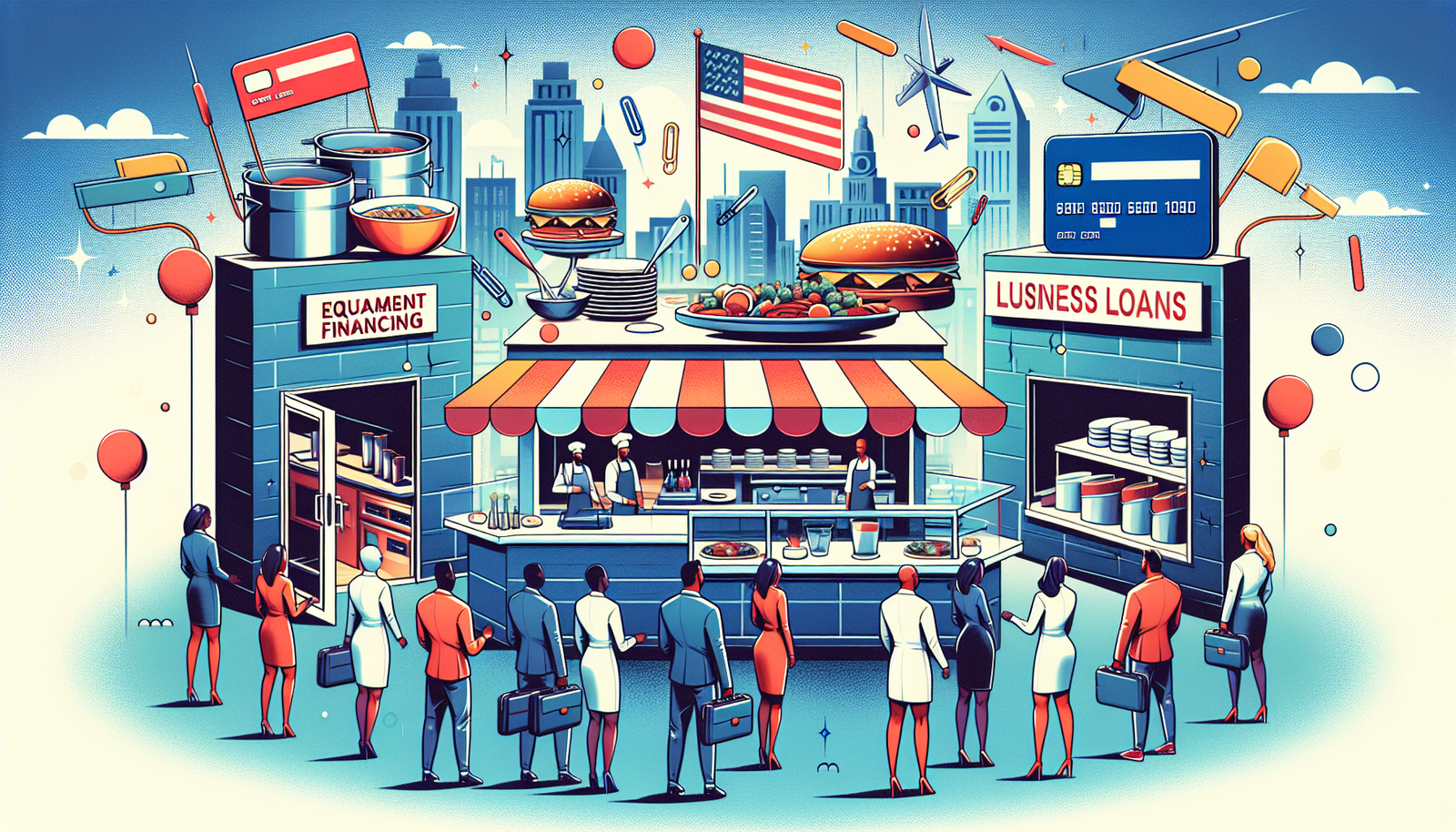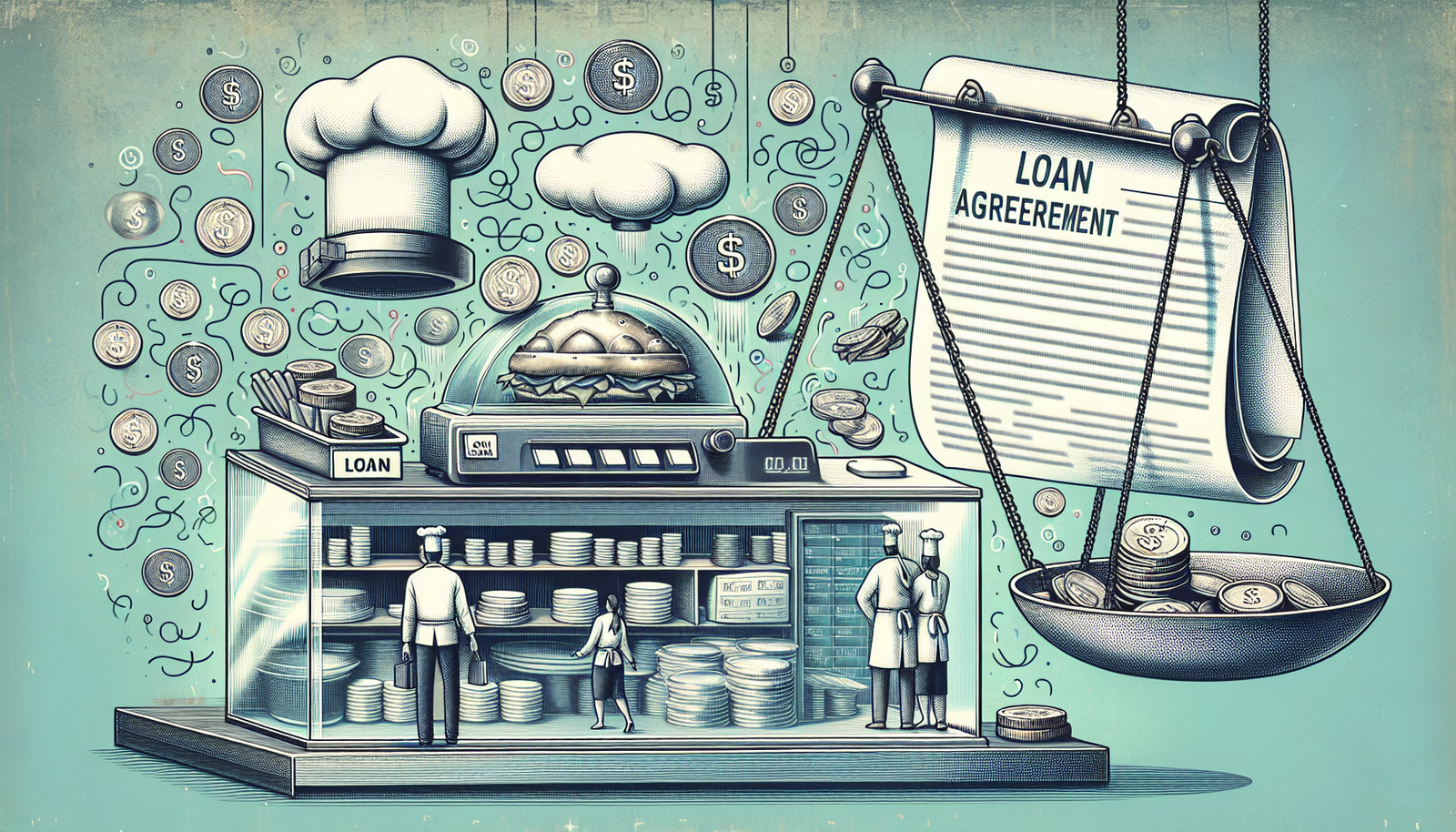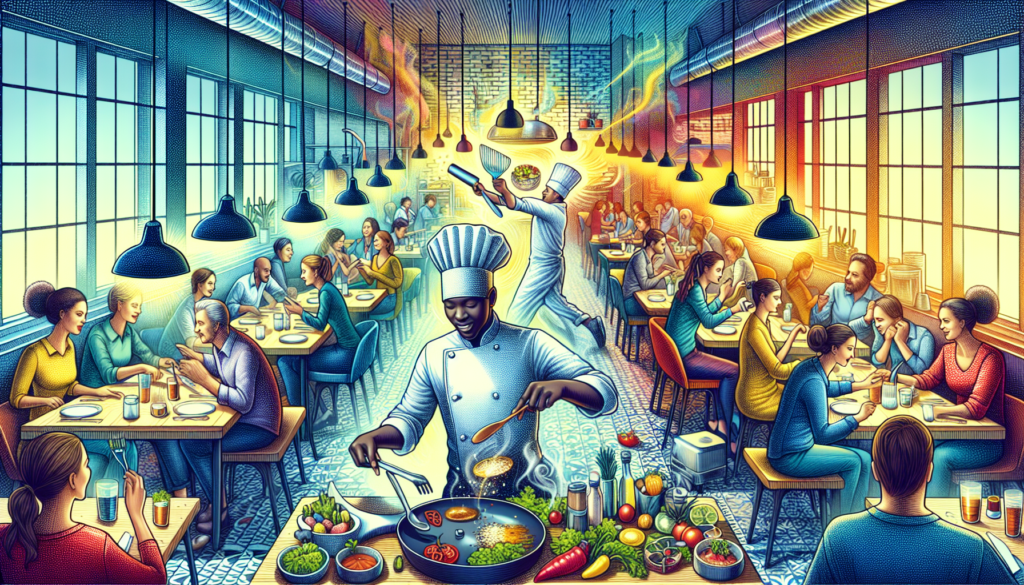Looking for a restaurant loan to fuel your culinary dreams? With an array if financing options at your disposal, choosing the right one can be key to your establishment’s success. This guide cuts through the industry jargon to provide you with clear insights on securing the funds you need, whether it’s for renovation, expansion, or keeping the kitchen running. Dive into our comprehensive analysis to understand how to navigate the restaurant loan landscape effectively without the sales pitch.
Key Takeaways
-
Restaurant loans offer diverse funding options with flexible repayment terms, and can facilitate quick access to capital for managing operating expenses and fostering growth.
-
The loan application process involves diligent preparation of a detailed business plan and important financial documents, with creditworthiness being a significant determinant of loan terms.
-
A variety of loan types exist to cater to different restaurant needs, from traditional SBA loans with low-interest rates to alternative lending options like merchant cash advances, each with its specific features and requirements.
Culinary Capital – A Closer Look at Restaurant Loans

Imagine a world where your restaurant’s aspirations are not just dreams but attainable realities. Restaurant loans promise to be the financial fuel for this journey, offering unique selling points such as flexible repayment options and the potential for quick funding. Yet, as we sit down to sample this potential feast of financial solutions, a critical eye must be cast upon these claims. Are these financing delicacies as delectable as they seem, or should one consider restaurant business loans or a commercial real estate loan as alternative options?
Lenders like Fundbox and Rapid Finance tantalize with their offers of flexible lines of credit and acceptance of some lower credit scores, suggesting that they are the perfect pairing for many business owners’ financial palates. The allure of quick access to capital, as provided by Fundbox, is akin to the rush of a fast-paced kitchen – essential and highly valued by restaurant owners who must often react swiftly to the dynamic demands of the industry.
Yet, the skeptic in us knows that not all that glitters is gold. The question lingers: will these financial products, like the ARF Financial short-term loans with their early repayment discounts and multiple loan options, truly deliver the flexibility they boast? As we prepare to put these claims to the test, it is clear that restaurant loans could be instrumental in covering operating expenses, from staffing to inventory management, and crucially, in funding the growth and expansion of our culinary enterprises.
As restaurateurs, it’s essential to partner with lenders who understand the heartbeat of our industry and can offer funds that add spice to our vision. A lender’s reputation, steeped in their understanding of the restaurant industry, forms part of the broth that will nourish a successful financing partnership. With a myriad of ways to utilize these loans, from revitalizing an existing location to upgrading restaurant equipment, the flexibility offered to business owners is indeed significant.
Recipe for Application – Navigating the Loan Process
The first step in our culinary financing journey is to meticulously plan our course, much like a chef designs a menu. The application for a business loan begins with a thorough evaluation of project costs and a deep dive into the capital required, setting a realistic timeline and determining payment affordability. But just like sourcing the best ingredients, researching lenders is crucial to understand their offerings, including interest rates and repayment flexibility.
Gathering the essential documents is akin to prepping your mise en place. Here are the documents you will need:
-
A detailed business plan
-
Credit scores
-
Licenses
-
Financial statements
These documents must be in perfect order to ensure a smooth application process. Thanks to the digital age, most restaurant loan applications can now be completed online, adding efficiency and speed to the submission process.
Creditworthiness, measured by the almighty credit score, significantly influences the seasoning of your loan terms. While lenders like SmartBiz and ApplePie Capital have set the bar at scores of 650 and 700 respectively, for their respective loans, SBA loans recommend a business credit score of 680 or higher. Yet, hope remains even for those with a credit score as modest as 500, with potential loans still within reach.
Applicants should be cognizant of the various ingredients that flavor their loan terms, from credit score to years in business and monthly sales volume. Hidden fees and whether the lender reports to credit bureaus should be on every restaurateur’s checklist. Certain lenders, such as Rapid Finance and OnDeck, may have specific appetizers on their menu, like a business banking account and three months of income information, all while showcasing a robust credit profile with steady cash flow.
Following document submission, lending decisions can arrive as quickly as a rush order, with Funding Circle capable of making loan decisions within a single day. Should the apron of approval be donned, the process from application to the serving of funds can be as swift as 10 days, a timeline that Fund Circle proudly offers.
Flavors of Funding – Exploring Loan Types

In the smorgasbord of restaurant financing, one can find a medley of loan types, including small business loans, each with its own unique taste and purpose. The SBA loans, backed by the Small Business Administration, offer a particularly competitive flavor. An sba loan includes:
-
low-interest rates
-
longer repayment terms
-
fewer restrictions on how the capital can be utilized
-
substantial amounts up to $5 million to restaurant owners
However, these loans often require a side of collateral as security.
Equipment financing is the perfect ingredient for restaurant owners looking to finance those essential assets like ovens and POS systems. Spreading the cost over time helps to preserve that crucial ingredient – working capital – and ensures that payments align with the equipment’s usage lifespan. A business line of credit, on the other hand, serves as a revolving source of funds up to $1 million, offering the flexibility to draw money as needed, which can be exceptionally beneficial for managing the unpredictable cash flow so characteristic of the restaurant industry.
For those seeking a less traditional route, alternative lenders dish out various options such as merchant cash advances. A merchant cash advance provides immediate capital in exchange for a portion of future revenue and is renowned for its flexibility and lenient credit requirements, making it an appealing choice for restaurant owners who encounter barriers with traditional lending. Another specialized tool is purchase order financing, which allows restaurants to secure the funds needed to fulfill large orders, like catering services, without compromising their cash flow.
As we savor the different funding options available, it’s essential to chew over the benefits and drawbacks each one presents. The right choice will depend on the specific needs and circumstances of your restaurant. Whether it’s for a quick infusion of cash or a significant investment in your business’s future, there is a financial flavor to suit every restaurateur’s taste.
Serving Up Solutions – Loan Terms and Features
When it comes to the culinary arts of financing, the terms of the loan you choose can be just as important as the dish itself. Term loans from traditional banks, for example, usually offer repayment periods ranging from 3 to 10 years. This duration deeply influences the seasoning of the interest rate and the total sum of interest paid over the life of the loan.
Understanding the true cost of a loan goes beyond the surface. The Annual Percentage Rate (APR) is a comprehensive measure that includes all interest, fees, and the timing of those fees. It’s the full recipe of the loan’s cost and is critical for restaurateurs to consider when evaluating their options.
Yet, just as a chef must choose between the stability of a tried-and-true recipe or the innovation of a new culinary creation, restaurants must decide between fixed interest rates, offering predictable payments, and variable rates, which can fluctuate with the market’s ebbs and flows. This decision can have a significant impact on the predictability of monthly payments and overall financial planning.
Adding to the mix is the consideration of collateral. Just as a chef might put up a prized recipe as a guarantee for a contest, often, a loan requires a guarantee in the form of business assets. Should the unfortunate scenario of default occur, the lender has the right to seize the collateral, such as kitchen equipment, to recuperate their investment.
The Financial Feast – Assessing Loan Impact

After securing the funds, it’s time to digest the financial impact of your restaurant loan. Much like a complex dish, the compounding of interest can add layers of cost that increase the total amount repayable if not addressed expediently. Short-term loans, while offering a rapid infusion of capital, often come with a higher APR and require more frequent payments, which can stretch a restaurant’s finances during lean periods.
The delicate balance of cash flow and working capital is essential for covering day-to-day operations such as payroll, equipment maintenance, and inventory. The ebbs and flows of seasonal demands can be navigated more deftly with the right financing in place, ensuring that the restaurant’s financial health remains robust even in the face of fluctuating revenues.
The Bottom Line – Is it Worth the Investment?
In the grand feast of restaurant financing, the right choice of investment can make or break your establishment’s success. It’s crucial to weigh the options and select a financial solution that complements your restaurant’s business model and growth strategy. Alongside traditional loans, a buffet of alternatives beckons – from merchant cash advances to lines of credit and invoice financing. Each offers a different set of flavors and must be carefully paired with your business’s unique palate.
Venturing into the territory of crowdfunding can provide restaurants with a cash infusion without the strings attached to traditional loans. This avenue can increase visibility, build community involvement, and serve as a test for your restaurant concept. However, it also comes with its own set of risks, including uncertain funding and the potential of overpromising to your supporters.
Specialized funding options, such as those offered by CAKE Capital and Parafin, cater specifically to the restaurant industry and present a low-risk alternative for owners. When considering these options, it’s important to savor the full flavor of a restaurant loan against these alternatives to determine the best choice for your financial palate.
Ultimately, the decision to invest in a restaurant loan should be made with a clear understanding of the potential return on investment. The right financing can provide the necessary ingredients for growth and success, but it must be chosen with care, ensuring that it aligns with your restaurant’s vision and long-term objectives.
Seasoning the Strategy – Loan Utilization Tips
Securing a loan is only the first step in the culinary journey of financing. The true art lies in the strategic allocation of capital, ensuring that every dollar works towards business growth. A masterful strategy involves investing loan funds in areas that have a direct and potent impact on enhancing your business, such as renovations or adopting new technologies.
Managing cash flow and working capital is a balancing act, especially when seasonal demands ebb and flow. Loans can provide the much-needed stability to cover operating costs, allowing the restaurant to maintain a consistent and high-quality experience for patrons.
For restaurants that are performing well in the restaurant business, reinvesting additional funds from loans can lead to improvements in the dining experience and upgrades to equipment, ultimately leading to increased revenue.
Digesting the Details – Understanding Repayment
Navigating the repayment landscape of restaurant loans can be as intricate as mastering the perfect soufflé. Understanding the repayment terms and aligning them with your financial capacity is crucial for a smooth repayment experience. However, it’s essential to be aware of the potential penalties for early repayment. Much like a chef must understand the nuances of each ingredient, a restaurateur must understand the implications of repaying a loan ahead of schedule.
The reputation of a lender can be as telling as a critic’s review. It’s important to consider their flexibility and understanding during times of financial hardship. Choosing a lender with a reputation for working with restaurateurs during challenging times can ease the repayment process and provide peace of mind.
Summary
As we wrap up our culinary tour of restaurant financing, it’s clear that the right loan can be a powerful tool for growth and success. From the myriad of funding options to strategic capital allocation and the nuances of repayment, savvy restaurateurs are equipped with the knowledge to make informed decisions. May this guide serve as your recipe for financial prosperity, inspiring you to craft a thriving restaurant that delights every palate.
Frequently Asked Questions
What are the benefits of an SBA loan for restaurant owners?
SBA loans provide restaurant owners with competitive financing, low-interest rates, longer repayment terms, and flexibility in capital usage, thanks to government backing, making them a beneficial option for business needs.
Can restaurant owners with low credit scores still obtain financing?
Yes, restaurant owners with low credit scores can still obtain financing from lenders such as Fundbox and Rapid Finance, which offer flexible options for those with less-than-stellar credit histories.
How can restaurant loans be used to drive business growth?
Restaurant loans can drive business growth by being strategically invested in renovations, technology upgrades, and improving the dining experience, while also helping balance cash flow and cover operating costs to maintain quality service and capitalize on revenue-increasing opportunities.
Are there any risks associated with crowdfunding as a financing option for restaurants?
Yes, while crowdfunding can provide increased visibility and community involvement, it also comes with risks such as uncertain funding levels and the possibility of overpromising to backers. Restaurants should carefully weigh these factors before opting for crowdfunding as a financing option.
What should restaurant owners consider when choosing repayment terms for a loan?
When choosing repayment terms for a loan, restaurant owners should consider their financial capacity and cash flow, understand the implications of fixed versus variable interest rates, potential prepayment penalties, and the lender’s flexibility during financial challenges.




